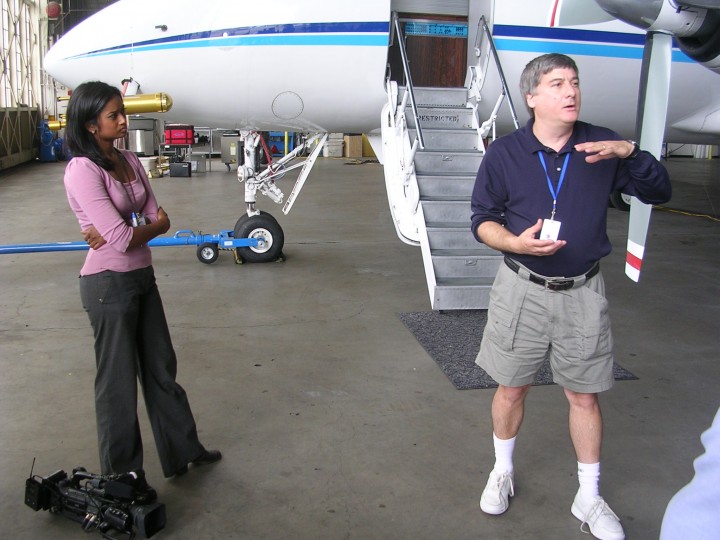

Today is a hard down day, long due after intense work around the aircraft and the two flights of yesterday. Things are definitely getting dirtier, and we started observing a decent amount of aerosols all along our flight trajectories.

I stitched this panorama of the McClellan airfield in between the two flights (2: 15 pm local time). On the extreme left, the tail of a 747, then that of a DC-8. Sometimes things just don’t fit right.
At right, the NASA King Air B-200 and the Department of Energy G-1 aircraft under careful maintenance of a member of the crew (“Wax on, wax off”). Note the sniffing tools (in gold color) close to the nose of the aircraft. Yummm…aerosols.
You can also see the presence of high cirrus clouds, not common in this season here in Sacramento. I’d much prefer not having them since they veil the Sun, which should instead shine unobstructed to guarantee a perfect interpretation of my polarimeter’s data (more about it in the next post).
-M.
There’s nothing special about Sacramento’s urban emissions per se, other than being very typical emissions from a city. So why was the campaign designed to take place here? The thing is that this region has a very well defined circulation pattern, which makes the plume transport very regular.
Southwesterly winds mix two airflows in the afternoon. The first is a persistent flow originating in the San Francisco Bay area. The second is more local and due to air being heated up in the Sierras, which draws the cooler air from the valley. Unless — there is always an unless — the flow gets disrupted by synoptic (read: large scale) storms born in the Pacific. This is apparently what we have been observing in the first days of the campaign, doomed by an unusual amount of mid-level clouds. NASA’s instruments usually fly at around 8-9 km, and these clouds partly spoil our ability to observe aerosols beneath.
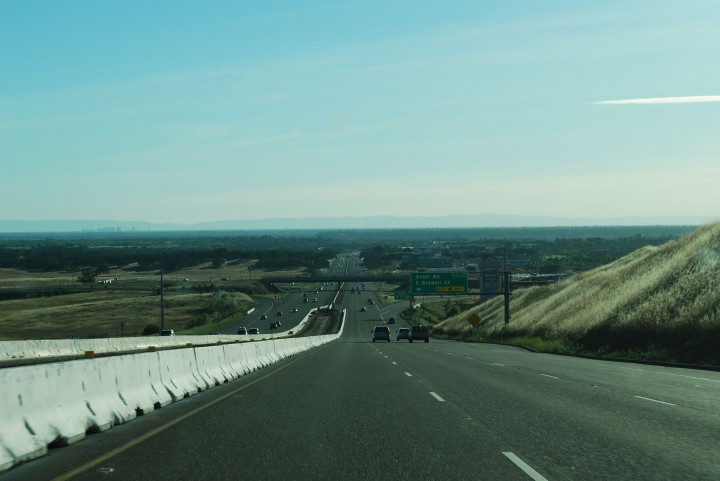
In any case, under normal conditions the resulting upslope flow transports the Sacramento’s plume towards the mountains, where anthropogenic aerosols interact with the biogenic sources from the forested areas, which are loaded with terpenes produced by the photosynthetic activity of vegetation. Recent research has shown that these biogenic sources could give an extra kick to the production of secondary organic aerosols of anthropogenic origin. “Secondary” here designates a zoo of different compounds generated by the interactions of “primary” substances with background conditions, leading to a myriad of chemical and physical transformations. An example? Humidity can coat aerosols of a thin film of water, drastically changing their properties.
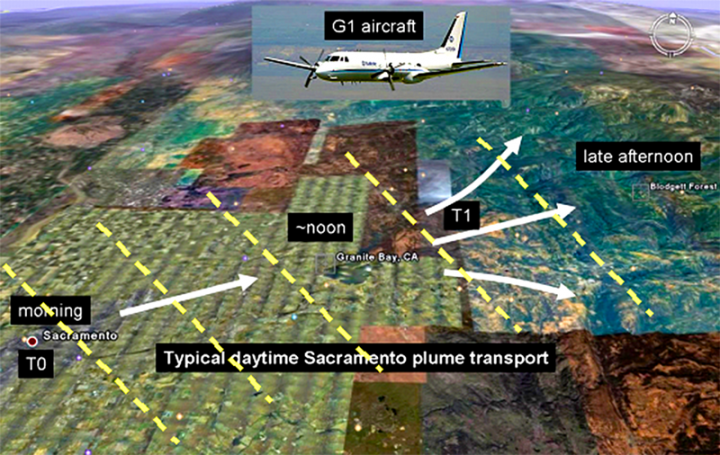
The overall goal of the mission is to follow the evolution of the plume, sampling the formation of secondary organics and the anthropogenic/biogenic mixing ratio. Of great avail is the Cool “T1” site downwind from the sources here in Sacramento, packed with instrumentation on the ground managed by the Department of Energy. It’s Cool, like in Cool, CA. This nearly uninhabited site will be regularly overflown by the airplanes involved in the campaign so that data from the different platforms can be compared and validated. You can’t have ground sites everywhere, so that’s why the DOE G-1 airplane samples the area in between, trying to fill the gap and find out what happens in between. Plus there is us – the NASA group. We observe the same aerosols from high above, so we provide scene context. Our instruments are prototypes of those that fly on satellites in space, which are so very important because they give continuous global coverage via the “remote sensing” technique, or “the art of collecting data form a distance”. Very politically correct.
I have to thank Jerome Fast, who has extensive experience as chief meteorologist in campaigns like CARES, for his punctual forecast in the daily briefings and the explanations that prompted this post.
-Matteo
There’s always a lot of people thanking each other in a campaign, but today the crew, the pilots, and whoever up there is responsible for good weather deserves all my kudos. I normally don’t get to sit on the airplane, as our instrument works as a Swiss clock and we prefer to save fuel to pull longer flight legs. Today the circumstances were atypical and I got to board, curiously on the day of the one-year anniversary form my previous flight, during the RACORO campaign in Oklahoma.

Touristic companies would have a hard time to match the quality of this Tour of California (and I didn’t have to pay for it). I have to share these pictures, although their quality doesn’t speak enough of the true beauty of the sight. In my partial defense, I must say that the small B200 is extremely crammed and taking a good shot requires leaning over the pilots, which is not something you want to do too often (all other windows are partially darkened).
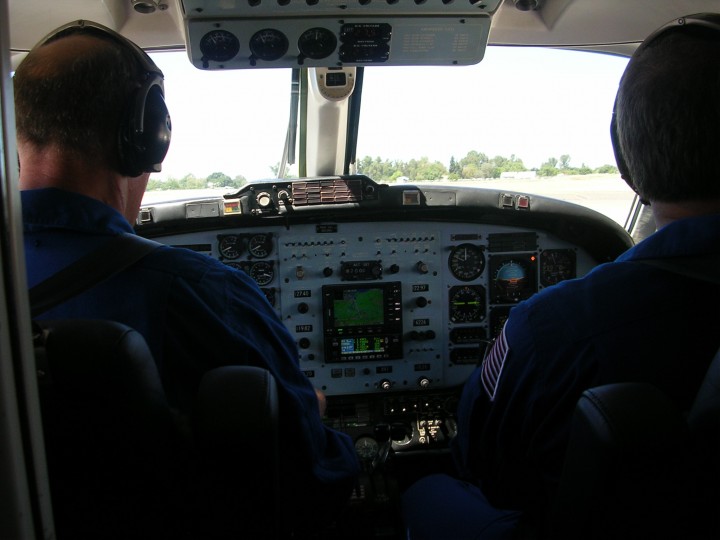
The route led us South of Sacramento along the San Joaquin valley, majestically shouldered by the Sierras still loaded with late spring snow.
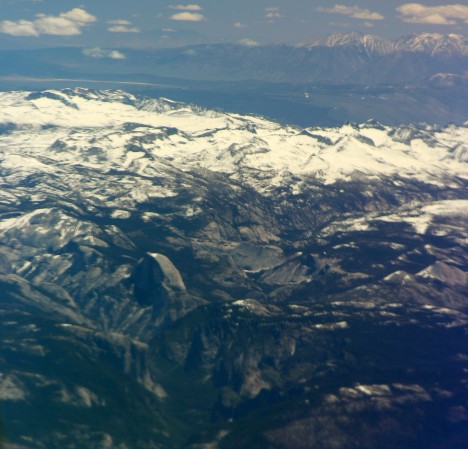
Fresno marked our big right turn toward the coast, right about when we spotted a small fire in the San Benito region.
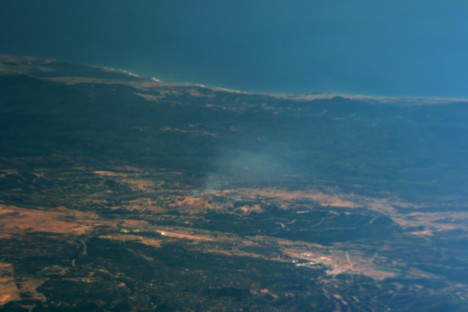
The flight plan required overpassing some ground stations at NASA Ames and in Monterey, so we were absolutely forced to come back along the Big Sur. Absolutely. It truly is a glorious coastline with surf clearly visible even from a 9km altitude. Cloud banks were innocuously looming from the ocean, a single tongue of fog daring to come further right there where it should be.
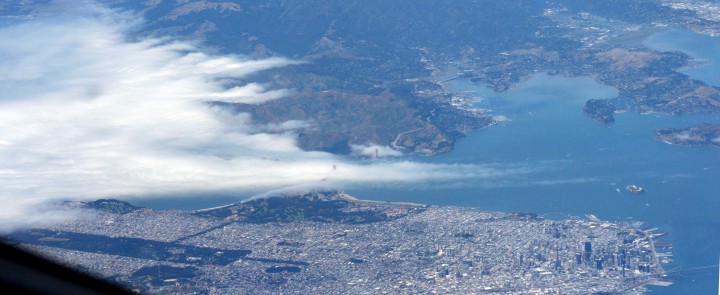
The final stretch was over the valleys of Napa and Sonoma, and shortly before touchdown over the only cloud bank the plane had to overfly.
I finally want to mention that yesterday was also “media” day. Here and here is what came out of it. By the way, if you happen to watch the videos, you should note that even if Rahul investigates scientific principles, that doesn’t make him a “principle investigator” as the banner reports. He’s the “principal investigator”. Don’t mean to brag too much about it, it’s just a matter of principle. Since we’re at it, measuring the composition of particles requires a “spectrometer” rather than an “aspectrometer”. Well, in a way we’re measuring the aspect of particles.
-Matteo
